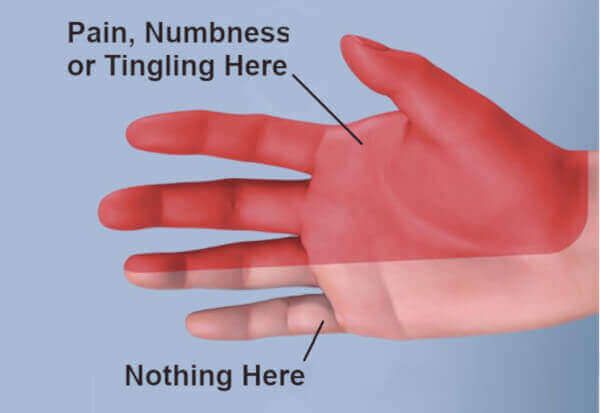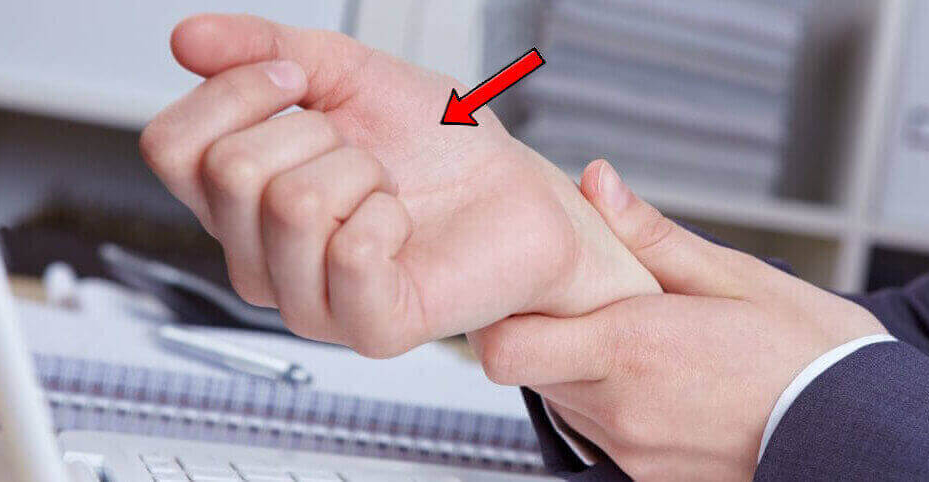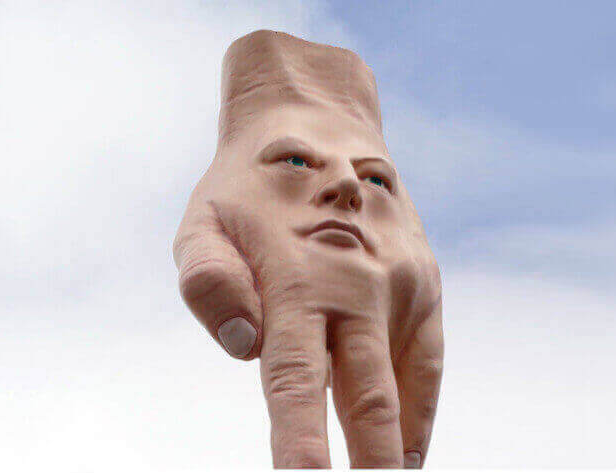Where Does Carpal Tunnel Hurt?
Table of Contents
- Overview
- How pain begins
- More severe symptoms
- Where does carpal tunnel hurt most?
- How to treat a hurting hand & fingers
1) Bracing at night
2) Rest
3) Stretching exercise
4) Myofascial massage
Overview
One of the most common questions doctors get is,
"Exactly
where does carpal tunnel hurt?"
This
is not so easy to answer. That's because everybody is different and feels this condition differently. But certain patterns and locations are similar. When the condition is just beginning, most patients with
carpal tunnel syndrome (usually just called "carpal tunnel") feel symptoms in their
fingers and hand. They start out with pain or numbness (or both). Sometimes tingling, soreness, and weakness accompany the pain. Most times the fingertips hurt the most, especially when you're trying to sleep at night. Usually it's your thumb and forefinger that hurt the most. Sometimes pain is accompanied by
numbness or tingling but other times it's not.
How pain begins
All carpal tunnel symptoms feel different from one person to the next. Yet, by far, most patients complain about pain or numbness in their fingers first, before any other symptoms appear. The pattern of how symptoms appear and how they progress are generally similar from person to person.
- For most patients, pain begins in the fingertips. It's usually accompanied by numbness or tingling. However, in carpal tunnel syndrome, no symptoms appear in the little (pinky) finger whatsoever. That's because it is not served by the median nerve.
- The pain, numbness, and tingling usually spreads to the base of the fingers (on the palm side) and also into the hand. The thumb, its base, and the pointer fingers are most commonly more involved (more intense) than the middle fingers.
- Pain and numbness generally first appears in the middle of the night. Most people say they need to wake up and “shake out” their numb hand or fingers. Ore else they have to wake up and rub their painful fingers. This frequently disturbs their sleep. But as the disorder worsens,
pain lasts into the daytime.
- It’s very unusual for symptoms of carpal tunnel to start quickly. Instead, they begin gradually and almost without notice. Usually a person will feel finger throbbing or pins-and-needles when their hand is at rest. In fact, many patients don’t feel they have carpal tunnel at all until they realize they're losing
finger dexterity or strength. It occurs to them that they can't easily button a shirt or pick up coins. Many say their hand feels clumsy.
- Along with hurting or numb hand and fingers, patients can also feel other symptoms. It’s not unusual for fingers to feel puffy, even though they’re not. Sometimes
burning or itching feelings occur. Other times,
electric shocks shoot up the arm, especially when grasping objects.
More severe symptoms
Without treatment, carpal tunnel symptoms worsen
66% of the time. In fact, it's usually during the stage of severe carpal tunnel syndrome that patients first seek medical help.
The level of pain intensity can increase gradually or quickly. However,
6-12 months after signs first appear, the majority of patients see symptoms reach the severe stage if they didn't already start treatment.
Generally, increased severity means most patients have hand or finger weakness and
loss of grip strength. For instance, it might be difficult to turn a doorknob, grip a bath towel or hold a steering wheel.
In more severe and chronic cases the patient can visibly see
wasting
of the muscles at the base of their thumb. That’s when the normally plump muscle mass flattens out and wrinkles. This is called
end stage
carpal tunnel syndrome.
It’s also common for patients with severe or end stage carpal tunnel syndrome to lose their sensation of hot and cold water. This is dangerous because it's easy to accidentally burn your fingers around boiling water.
Whether you have painful or numb fingers from carpal tunnel in one hand, symptoms will likely begin on the other hand as well. Carpal tunnel syndrome is a
bilateral condition. It means you have an 80% chance that both hands will exhibit symptoms. Sometimes, the sensations start in both hands at the same time.
Where does carpal tunnel hurt most?
Ask any patient where carpal tunnel hurts the most and the answer is almost always,
"MY THUMB!" Usually the forefinger runs a close second. But that's not a rule.
Sometimes the middle fingers hurt more than the thumb. And it's not unusual for the entire palm to hurt as well. On rare occasion, the wrist is most painful.
The pain can be sharp or dull, shooting or stabbing. The intensity ranges from slightly annoying to cruel and punishing. It's common for pain to feel like an electric shock shooting out of the palm and up the arm.
Once again, the little finger is never involved. And neither is the top side of the hand. But sometimes pain is so intense that it feels like your entire hand and all fingers are being crushed to death.
It's usually at this severe stage that patients say,
"I feel like I want to cut off my hand!"
How to treat a hurting hand & fingers
Most people don’t realize they can treat a painful hand and fingers very effectively without surgery.
The key is to attack the symptoms
before
they reach the severe level.
Every doctor knows that treating carpal tunnel when it’s
mild (or moderate) is much easier than when it’s severe. So treatment should begin as quickly as possible – preferably at the
first sign of carpal tunnel syndrome .
The most effective treatments address tissue inflammation which causes swelling and pressure inside the wrist joint. The treatment
combination that works best is Night bracing, Rest, Stretching exercises, and Myofascial massage.
All four treatments should be used simultaneously to get the best results.
1) Night bracing
2) Rest
3) Stretching exercise
4) Myofascial massage
Summary
Where does carpal tunnel hurt the most? The answer is different for everybody. However, usually the thumb and forefinger are the most painful and intense. The pain is also usually accompanied by numbness. If you don't treat carpal tunnel immediately, most of the time symptoms will worsen. And if they reach the severe stage, the condition will be much more difficult to treat.
FAQs
- If my thumb hurts now from carpal tunnel, will my other fingers hurt later on?
It's impossible to tell. But generally, symptoms (including pain) will spread to to other fingers if you do not treat it.
- My pain is on and off, not constant. Sometimes it flares up. Is all that normal?
Especially in the mild or moderate stage, carpal tunnel pain can flare up and then die down. This intermittent pain is common. But as the condition progresses, the pain will become more constant.
- What happens if I try every conservative, nonsurgical remedy but my hand still hurts?
You still have options. You can consider
hydrodissection and
carpal tunnel surgery.
About










